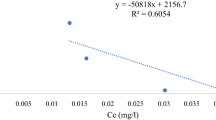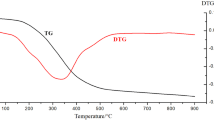Abstract
Chromite ore processing residues (COPR) is the source of the Cr(VI) contamination in the environment. Pannonibacter phragmitetus BB was used to treat two different types of COPRs in this research. The water-soluble Cr(VI) of COPR A and B is 3,982.9 and 1,181.4 mg/kg, respectively. In the column biotreatment process, P. phragmitetus BB can reduce Cr(VI) in the leachate to an undetectable level at the flow rate of 1 and 2 ml/min. In the direct biotreatment process, Cr(VI) in the liquid supernatant of COPR A and B decreased from 265 and 200 mg/l to 145 and 40 mg/kg after 240 h of incubation. In one-step and two-step biotreatment processes, Cr(VI) in the liquid supernatant of both COPRs can be reduced to an undetectable level. The toxicity characteristic leaching procedure results indicate that the Cr(VI) concentration of treated COPR A (3.48 mg/l) is lower than the identification standards for hazardous wastes of China (5 mg/l) (GB 5085.6-2007). The information obtained in this study has significance for the application of P. phragmitetus BB to remediate COPR contamination.







Similar content being viewed by others
Reference
Ahmad WA, Zakaria ZA, Khasim AR, Alias MA, Ismail S (2010) Pilot-scale removal of chromium from industrial wastewater using the ChromeBac™ system. Bioresour Technol 101:4371–4378
Bagchi D, Stohs SJ, Downs BW, Bagchi M, Preuss HG (2002) Cytotoxicity and oxidative mechanisms of different forms of chromium. Toxicology 180:5–22
Batool R, Hasnain S (2012) Hexavalent chromium reduction by bacteria from tannery effluent. J Microbiol Biotechnol 22:547–554
Chai L, Huang S, Yang ZH, Peng B, Chen YH (2009a) Hexavalent chromium reduction by Pannonibacter phragmitetus BB isolated from soil under chromium-containing slag heap. J Environ Sci Heal A 44:615–622
Chai L, Huang S, Yang Z, Peng B, Huang Y, Chen Y (2009b) Cr(VI) remediation by indigenous bacteria in soils contaminated by chromium-containing slag. J Hazard Mater 167:516–522
Chrysochoou M, Dermatas D (2007) Application of the Rietveld method to assess chromium (VI) speciation in chromite ore processing residue. J Hazard Mater 141:370–377
Chrysochoou M, Fakra SC, Marcus MA, Moon DH, Dermatas D (2009) Microstructural analyses of Cr (VI) speciation in chromite ore processing residue (COPR). Environ Sci Technol 43:5461–5466
Costa M (1997) Toxicity and carcinogenicity of Cr (VI) in animal models and humans. Crit Rev Biotechnol 27:431–442
Darrie G (2001) Commercial extraction technology and process waste disposal in the manufacture of chromium chemicals from ore. Environ Geochem Health 23:187–193
Dermatas D, Chrysochoou M, Moon DH, Grubb DG, Wazne M, Christodoulatos C (2006) Ettringite-induced heave in chromite ore processing residue (COPR) upon ferrous sulfate treatment. Environ Sci Technol 40:5786–5792
Elangovan R, Abhipsa S, Rohit B, Ligy P, Chandraraj K (2006) Reduction of Cr (VI) by a Bacillus sp. Biotechnol Lett 28:247–252
Ganguli A, Tripathi AK (2002) Bioremediation of toxic chromium from electroplating effluent by chromate-reducing Pseudomonas aeruginosa A2 Chr in two bioreactors. Appl Microbiol Biotechnol 58:416–420
Geelhoed JS, Meeussen J, Roe MJ, Hillier S, Thomas RP, Farmer JG, Paterson E (2003) Chromium remediation or release? Effect of iron (II) sulfate addition on chromium (VI) leaching from columns of chromite ore processing residue. Environ Sci Technol 37:3206–3213
Graham MC, Farmer JG, Anderson P, Paterson E, Hillier S, Lumsdon DG, Bewley RJ (2006) Calcium polysulfide remediation of hexavalent chromium contamination from chromite ore processing residue. Sci Total Environ 364:32–44
Han X, Wong Y, Wong M, Tam N (2007) Biosorption and bioreduction of Cr (VI) by a microalgal isolate, Chlorella miniata. J Hazard Mater 146:65–72
Karanfil T, Kitis M, Kilduff JE, Wigton A (1999) Role of granular activated carbon surface chemistry on the adsorption of organic compounds. 2. Natural organic matter. Environ Sci Technol 33:3225–3233
Kwon KD, Green H, Bjöörn P, Kubicki JD (2006) Model bacterial extracellular polysaccharide adsorption onto silica and alumina: quartz crystal microbalance with dissipation monitoring of dextran adsorption. Environ Sci Technol 40:7739–7744
Liu YG, Xu WH, Zeng GM, Li X, Gao H (2006) Cr (VI) reduction by Bacillus sp. isolated from chromium landfill. Process Biochem 41:1981–1986
Losi ME, Amrhein C, Frankenberger WT (1994) Bioremediation of chromate-contaminated groundwater by reduction and precipitation in surface soils. J Environ Qual 23:1141–1150
Meena AK, Mishra GK, Rai PK, Rajagopal C, Nagar PN (2005) Removal of heavy metal ions from aqueous solutions using carbon aerogel as an adsorbent. J Hazard Mater 122:161–170
Moon DH, Wazne M, Dermatas D, Christodoulatos C, Sanchez AM, Grubb DG, Chrysochoou M, Kim MG (2007) Long-term treatment issues with chromite ore processing residue (COPR): Cr6+ reduction and heave. J Hazard Mater 143:629–635
Moon DH, Wazne M, Jagupilla SC, Christodoulatos C, Kim MG, Koutsospyros A (2008) Particle size and pH effects on remediation of chromite ore processing residue using calcium polysulfide (CaS5). Sci Total Environ 399:2–10
Panda J, Sarkar P (2012) Bioremediation of chromium by novel strains Enterobacter aerogenes T2 and Acinetobacter sp. PD 12 S2. Environ Sci Pollut Res 19:1809–1817
Polti MA, García RO, Amoroso MJ, Abate CM (2009) Bioremediation of chromium (VI) contaminated soil by Streptomyces sp. MC1. J Basic Microb 49:285–292
Poopal AC, Laxman RS (2009) Chromate reduction by PVA-alginate immobilized Streptomyces griseus in a bioreactor. Biotechnol Lett 31:71–76
Rivera-Utrilla J, Bautista-Toledo I, Ferro-García MA, Moreno-Castilla C (2001) Activated carbon surface modifications by adsorption of bacteria and their effect on aqueous lead adsorption. J Chem Technol Biotechnol 76:1209–1215
Sharma DC, Forster CF (1994) The treatment of chromium wastewaters using the sorptive potential of leaf mould. Bioresour Technol 49:31–40
Sultan S, Hasnain S (2007) Reduction of toxic hexavalent chromium by Ochrobactrum intermedium strain SDCr-5 stimulated by heavy metals. Bioresour Technol 98:340–344
Thomas RP, Hillier SJ, Roe MJ, Geelhoed JS, Graham MC, Paterson E, Farmer JG (2001) Analytical characterization of solid-and solution-phase chromium species at COPR-contaminated sites. Environ Geochem Health 23:195–199
Tinjum JM (2007) Mineralogical properties of chromium ore processing residue and chemical remediation strategies. Ph.D. dissertation, University Wisconsin–Madison, Madison
Tinjum JM, Benson CH, Edil TB (2008) Mobilization of Cr (VI) from chromite ore processing residue through acid treatment. Sci Total Environ 391:13–25
USEPA (1992) Method 1311: toxicity characteristic leaching procedure, In: Office of Solid Waste and Emergency Response (Ed.), Test methods for evaluating solid waste, SW-846, U.S. Environmental Protection Agency, Washington, DC
Wazne M, Jagupilla SC, Moon DH, Christodoulatos C, Koutsospyros A (2008) Leaching mechanisms of Cr (VI) from chromite ore processing residue. J Environ Qual 37:2125–2134
Whittleston RA, Stewart DI, Mortimer R, Tilt ZC, Brown AP, Geraki K, Burke IT (2011) Chromate reduction in Fe (II)-containing soil affected by hyper alkaline leachate from chromite ore processing residue. J Hazard Mater 194:15–23
Wu P, Li S, Ju L, Zhu N, Wu J, Li P, Dang Z (2012) Mechanism of the reduction of hexavalent chromium by organo-montmorillonite supported iron nanoparticles. J Hazard Mater 219:283–288
Xu L, Luo M, Li W, Wei X, Xie K, Liu L, Jiang C, Liu H (2011) Reduction of hexavalent chromium by Pannonibacter phragmitetus LSSE-09 stimulated with external electron donors under alkaline conditions. J Hazard Mater 185:1169–1176
Zhang D, He S, Dai L, Hu X, Wu D, Peng K, Bu G, Pang H, Kong H (2009a) Treatment of chromite ore processing residue by pyrolysis with rice straw. Chemosphere 77:1143–1145
Zhang D, Kong H, Wu D, He S, Hu Z, Hu X (2009b) Remediation of chromite ore processing residue by pyrolysis process with sewage sludge. Bioresour Technol 100:2874–2877
Acknowledgments
This work was supported by the National Funds for Distinguished Young Scientist (50925417), the National Natural Science Foundation of China (51074191), and the National “Twelfth Five-Year” Plan for Science and Technology Support (2012BAC09B04).
Author information
Authors and Affiliations
Corresponding author
Additional information
Responsible editor: Philippe Garrigues
Rights and permissions
About this article
Cite this article
Wang, Y., Yang, Z., Peng, B. et al. Biotreatment of chromite ore processing residue by Pannonibacter phragmitetus BB. Environ Sci Pollut Res 20, 5593–5602 (2013). https://doi.org/10.1007/s11356-013-1526-z
Received:
Accepted:
Published:
Issue Date:
DOI: https://doi.org/10.1007/s11356-013-1526-z




